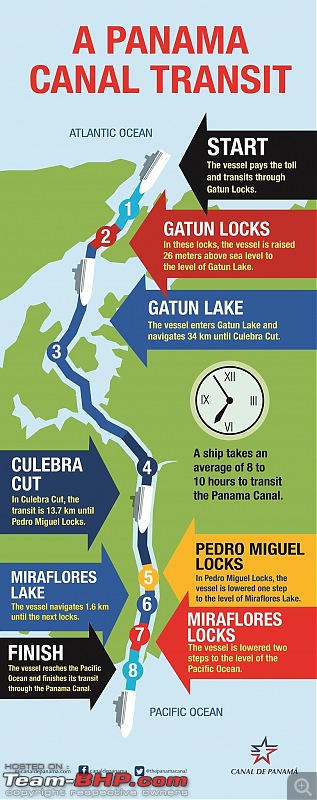| Re: 200 ships are in a traffic jam outside the Panama Canal
On an average about 40 ships cross the Panama canal everyday. 
Credits: @thepanamaCanal/Twitter
Every time a ship traverses the Panama Canal, about 50 million gallons of water has to be pumped into the Canal’s locks, which is a staged system that gradually raises and lowers the ships for their 50-mile journey across the Panamanian isthmus. And where does this water come from? From Gatún lake, a 164 sq.mile body of water located 88 feet above sea level, and the 20 sq.mile Madden lake, located 250 feet above sea level. Both of these lakes were formed by the damming of the Chagres River early in the 20th century, when the Panama Canal was built.
How does level of water affect these ships? The smooth functioning of the Panama Canal depends upon the water levels in Lake Gatún and Lake Madden. In the case of Lake Gatun, if the water level drops below 79 feet, the canal must restrict its maximum allowable draft, meaning ships are required to pass with less cargo. Lesser cargo on board and delayed transits + delayed delivery incurs losses to ship Owners.
The water level in the lakes of the Panama canal is dependent upon rain, Panama being a country of Tropical Rainforest and receiving over 2,000mm of rain throughout the year.
Much of Central America, including Panama, has been in significant drought in recent months. With the start of El Niño, it has further worsened the conditions. El Niño is a natural phenomenon in the tropical Pacific Ocean, typically brings warmer-than-average temperatures. This year, El Niño is expected to increase global temperatures, and could push 2023 or 2024 to be the warmest year on record. Quote:
Some shipowners have resorted to rerouting their journeys to avoid the backlog.
The canal uses three times as much water as New York City on a daily basis and needs rainfall to replace it.
But the rainy season is yet to arrive in Panama and the canal is going through its driest spell in more than a century.
Restrictions for the number of vessels passing through has been extended until September 2.
'The delays are changing by the day. Once you make a decision to go there is no point to return or deviate, so you can get stuck,' Tim Hansen, chief commercial officer at Dorian LPG, which operates large gas carriers, told the Wall Street Journal.
Without enough rain, the ship transits are cut and the lucky ones that cross pay hefty premiums.
This increases transport costs for cargo owners like American oil as well as Asian importers and gas exporters.
Ricaurte Vásquez Morales, the administrator of the Panama Canal, warned the restrictions could have to remain in place until the rest of the year.
He said the drought could see a $200million drop in revenue next year if the low rainfall continues into winter.
Conditions of extreme rain or drought are a lot more regular than in the early years of the canal's operation, according to him.
It presents a huge challenge for the Panama Canal Authority which supplies water to around half the country's population of 4.5 million.
'The Canal communicates with its customers so that the information allows them to make the best decisions even if it means that they may choose another route temporarily,' Vásquez Morales said.
'Demand remains high which proves the Panama Canal remains competitive in most segments, even with measures to save water.'
Operators have hired the US Army Corps of Engineers, who originally built the canal, and has set aside $2billion over the next decade to divert four rivers into the waterway and help ships flow through.
The canal already has three rivers that feed into it.
Wide disruption has not been caused for containerships which are the canal's biggest users.
Most are given preferential status because they work on fixed schedules and book crossings up to a year in advance.
|
Source: https://www.dailymail.co.uk/news/art...el-prices.html
Last edited by ruzbehxyz : 23rd August 2023 at 17:08.
|  (16)
Thanks
(16)
Thanks
 (13)
Thanks
(13)
Thanks

 (1)
Thanks
(1)
Thanks
 (1)
Thanks
(1)
Thanks






